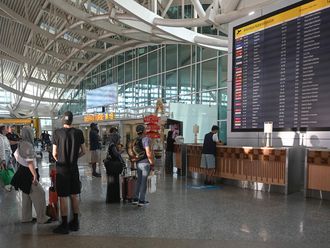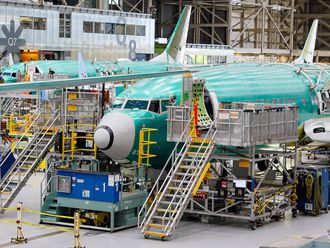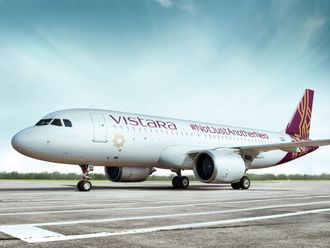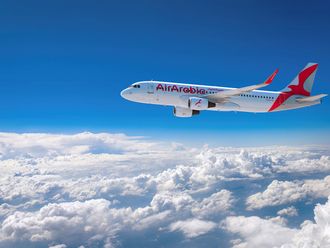Paris: Airbus could steal the Paris air show with a flypast of its newest passenger jet, the A350, as confidence grows over a maiden flight some four weeks away.
The timescales of its previous airliner launches suggest the European manufacturer could be ready to fly the aircraft in mid-June, depending on weather and ground trials, giving pilots a narrow time window to test the plane’s basic characteristics in flight before the June 17-23 air show.
With just a few hours in the air, industry sources say it is unlikely that the first completed A350, rolled out of the Airbus paint shop only last week, will actually land at the show.
But if the first handful of flights go to plan, a 600km trip to Le Bourget for a brief roar over its American rivals would ratchet up the PR war just as Boeing aims to recover from a three-month grounding of its 787 Dreamliner.
Airbus reiterated it plans to fly the A350 around the middle of the year and declined further comment on the plane’s debut.
However, the prospect of Airbus flaunting its newest jet from the air increased as photographs of an A350 logo painted on the plane’s belly circulated on the internet. Such belly markings are typically used for branding in air show flypasts.
Media were kept away from a staff-only unveiling last week, but a corner of what looked like an A350 logo was just visible on official video that otherwise showed little of the underside, tweeted David Kaminski-Morrow of aviation website Flightglobal.
A flying debut is the signature moment in the development of any new plane, when the industry goes into publicity overdrive. The first tests may also give Airbus the first indications of whether a $15-billion gamble on an aircraft to rival Boeing’s 787 Dreamliner has paid off. The A350 is designed to offer airlines big savings on fuel thanks to a lightweight structure that follows on the heels of Boeing’s carbon-composite 787.
“If everything goes well, you can do a quick check of cruise performance even on the first flight,” said Claude Lelaie, who was head of flight testing at Airbus before he retired.
“Everyone is usually anxious to have a very preliminary idea of performance, and especially fuel consumption,” he said. He declined to comment specifically on the A350.
Upbeat mood
Airbus is keeping a tight lid on the A350’s progress ahead of the maiden flight and broke with tradition by deciding not to hold a lavish “roll-out” party for its new model.
But suppliers say the mood emanating from the A350 design team is notably more upbeat than the painful launch almost a decade ago of the A380 superjumbo, the world’s largest airliner.
Before flying, the A350 must pass a series of ground tests.
“No machine as complex can be perfect straight away,” said Lelaie, who took the A380 on its maiden flight in April 2005.
The timing of the equivalent first flight for the A350 will depend in part on when Lelaie’s successors in the flight team agree to take the aircraft from the developers.
That is a decision not even top managers can impose on the elite corps of pilots and flight test engineers who, with their own lives at stake, have final say over whether to accept delivery of the jet, just as though they were outside customers.
“It is another world. Flight Test do not think about shows. They fly when they are ready,” said an industry executive.
The A380 debut was delayed when crew rejected the double-decker plane until a landing-gear problem had been addressed.
Flight test scrutiny
Based on past launches, the timing of last week’s unveiling is consistent with a handover to test crews near the end of May and a maiden flight two weeks later, but the schedule is tight.
The A380 was handed to the Flight Test Centre on April 6, 2005 after a two-week handover process and first flew on April 27 - about 35 days from the start of the handover. Eight years on, the A350 left the paint shop on May 12, leaving a total of just 28 days before the start of the air show.
In a book last year, Lelaie described how a year of flight testing on the A380 was complicated by mistrust between pilots and management. Analysts say such tensions have eased, however.
Following delays on civil and military projects worldwide, Airbus slowed development of the A350 to avoid skating over problems that might end up costing more and taking longer to fix. Even so, analysts say intense scrutiny of the A350 will not go away until well after the first jet enters service in 2014.
Performance tests at cruising altitude will be vital. That height is where the industry’s big jets spend most of their economically useful career of 22-23 years and fuel is the major factor in deciding whether to buy a long-range airliner.
While dedicated fuel-burn tests come later, Airbus will be looking to early flights to check the credibility of guarantees it has given on fuel consumption to the 35 customers which have already placed orders for 617 of its new twin-engined jet.
Its rival, the 787 first flown in 2009, is now returning to service after battery overheating caused a worldwide grounding and Boeing is expected to give it a big publicity push at Paris.












